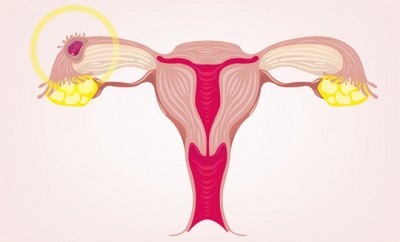Implantation Bleeding or Period? 5 Leading Signs of Implantation Spotting
Implantation bleeding is one of the first pregnancy signs, but women often take this type of light spotting for their regular period. However, it may be easily identified, if you know its 5 simple characteristics. Read how to distinguish implantation bleeding from your period, taking into account timing, character, color and duration of the bloody discharge.
Understanding the Mechanism of Implantation Bleeding
Implantation bleeding or period? Women often ask this question with hope or fear, in regards to whether hypothetical pregnancy is desirable at the moment or not. Actually, implantation bleeding is nothing else than a scanty bloody discharge of pinkish or brownish color. It occurs not in every woman and lasts normally just for a couple of hours. Nevertheless, in rare cases implantation discharge may continue for 1-2 days which is the major reason why it’s often taken for the beginning of the regular period. So, why don’t we dot all the i’s in this mishmash?
Implantation bleeding is one of the earliest pregnancy signs, revealing itself even before you can notice that your period is late. Let`s investigate how pregnancy starts from the very beginning and we`ll better understand the whole topic.
Impregnation may happen during ovulation or right after it. This day, when you are the most fertile, normally starts in the middle of the cycle. For example, if your menstrual cycle is 30 days, ovulation occurs on the 13th – 16th day. About 10 days more are needed for the mature ovum to migrate through the Fallopian tubes into the uterus. Therefore, the process of the ovum’s embedment into the uterine wall can begin approximately on the 23rd – 28th day of your menstrual cycle. As a result, implantation spotting is possible a few days prior to the date of your period in the current month. This is why you can take it for early menstruation.

The first thing you must know is that implantation bleeding is a normal phenomenon for the female organism and the first symptom, indicating that you are definitely pregnant. From now on your body is going to launch a global hormonal rearrangement. Spotting during implantation doesn’t have any impact on pregnancy itself. It rather gives you a personal privilege to determine your pregnancy even earlier than a hCG-test can do this.
The problem is that women often take pathological vaginal discharge with blood for implantation bleeding. You must be alarmed if your discharge is accompanied by strong lower abdominal pain, severe nausea, sudden vomiting and dizziness. These can be the symptoms of ectopic pregnancy or miscarriage. Such conditions require urgent medical help.

Leading Signs of Implantation Bleeding
- How does implantation bleeding look like? In the majority of cases it is a scanty discharge, usually lighter or sometimes darker in color than regular menstruation flow. The term “bleeding” here is rather relative. In reality you may spot just 1-2 bloody drops on your panty liner that are almost never bright red. Usually this discharge is pinkish or yellowish with a few bloody streaks. Read more in article: What Does Implantation Bleeding Look Like?
- How does it feel? Bloody discharge during implantation is associated with partial destruction of the uterine vessels when the fertilized egg embeds itself into the uterine wall. At this moment cramps of uterine muscles occur, which can cause slight pulling pains in the lower abdomen. Read more in article: Can You Feel Implantation? A Guide To Implantation Bleeding.
- When does it happen? Remember the date of your last period. With a stable menstrual cycle of 28-30 days, ovulation occurs on the 13th-16th day and implantation is possible within the next 10 days after ovulation. Implantation bleeding may be experienced 2-7 days before the beginning of the regular menstruation. Read more in article: When does Implantation Occur in Pregnancy and Women Opting for IVF.
- How long does it last? As a rule, its duration is limited to a few hours, 1-2 days in exceptional cases. Implantation bleeding cannot last for 5 or 7 days, it`s abnormal. Read more in article: How Long Does Implantation Bleeding Last?
- How does your basal body temperature change? In the 2nd phase of menstrual cycle the basal body temperature rises above 98.6°F and stays at the same level for about 2 weeks. If implantation occurs, basal temperature drops below 98.6°F with a sharp rise followed afterwards.
Implantation Bleeding or Period? How to Tell One from the Other?
There are several ways more you can distinguish implantation bleeding from your period. Remember about:
- Timing.
Implantation bleeding starts approximately in a week before period. Thus, bloody discharge after ovulation is likely to indicate possible conception. Bloody discharge after missed period is in question, the majority of gynecologists claim it`s impossible.
- Character of the bloody discharge.
We know that implantation bleeding looks like spotting. At the same time period usually starts from the similar scanty discharge with blood that is intensifying during the next few days. In rare cases implantation bleeding occurs shortly before period or even during period. In this case you should pay attention to the character of your discharge. If it is slight and do not intensify, it can be the sign of successful conception and implantation.
- Additional testing.
If you notice the typical bloody discharge you may make a pregnancy test. It can be already taken on the 8th–10th day after ovulation. However, do not expect the brilliant accuracy. If your hCG-level is not enough yet, the home pregnancy test will show you the false negative result. Try again later, better in a week or two.

“Implantation bleeding or period?” this question should no longer vex your mind. The differences in timing, character and duration are quite evident. Besides, implantation bleeding isn’t a very wide-spread phenomenon, plus in other cases it passes unnoticed. Anyway, possessing useful information and being attentive to the slightest changes in your organism’s reactions, you will be able to determine conception before the positive result of a pregnancy test.
Recommended reading:
What Does Implantation Bleeding Look Like?
Spotting A Week Before Period: Should You Be Worried?
When Does Implantation Bleeding Occur?
What Is Implantation Bleeding and When Does Implantation Bleeding Occur?
What Does Implantation Bleeding Color Tell About Your Reproductive Health?
Can Implantation Bleeding Be Heavy? Truth Unraveled
Does Implantation Bleeding Have Clots? Truth Divulged
Can Implantation Bleeding Be Bright Red Key Facts Revealed
Signs of Implantation Bleeding – Implantation Bleeding and Symptoms
Can You Feel Implantation? A Guide To Implantation Bleeding













